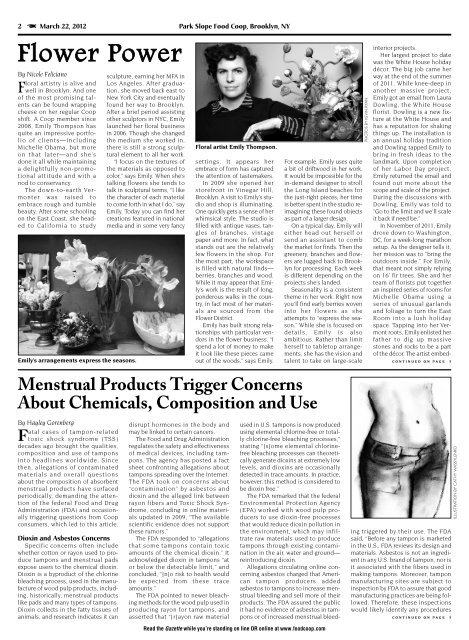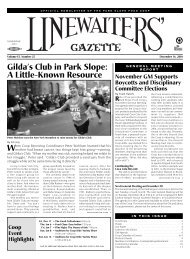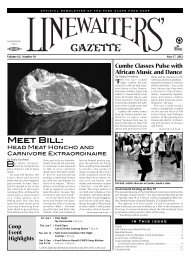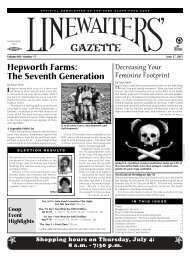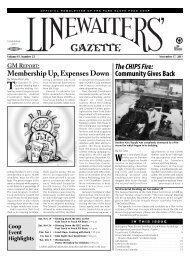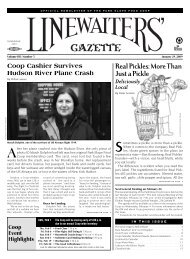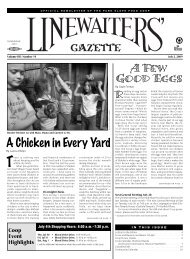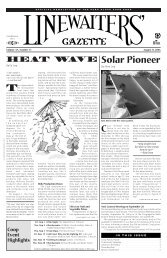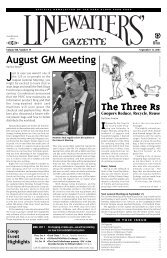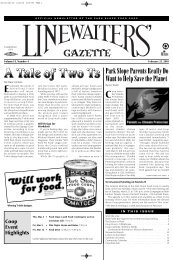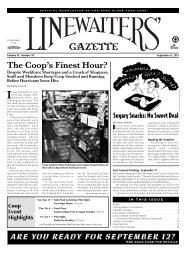February 2012 General Meeting - Park Slope Food Coop
February 2012 General Meeting - Park Slope Food Coop
February 2012 General Meeting - Park Slope Food Coop
You also want an ePaper? Increase the reach of your titles
YUMPU automatically turns print PDFs into web optimized ePapers that Google loves.
12_03-22 p01-20_Layout 1 3/21/12 5:54 PM Page 2<br />
2 March 22, <strong>2012</strong> <strong>Park</strong> <strong>Slope</strong> <strong>Food</strong> <strong>Coop</strong>, Brooklyn, NY<br />
Flower Power<br />
By Nicole Feliciano<br />
Floral artistry is alive and<br />
well in Brooklyn. And one<br />
of the most promising talents<br />
can be found wrapping<br />
cheese on her regular <strong>Coop</strong><br />
shift. A <strong>Coop</strong> member since<br />
2008, Emily Thompson has<br />
quite an impressive portfolio<br />
of clients—including<br />
Michelle Obama, but more<br />
on that later—and she’s<br />
done it all while maintaining<br />
a delightfully non-promotional<br />
attitude and with a<br />
nod to conservancy.<br />
The down-to-earth Vermonter<br />
was raised to<br />
embrace rough and tumble<br />
beauty. After some schooling<br />
on the East Coast, she headed<br />
to California to study<br />
By Hayley Gorenberg<br />
Fatal cases of tampon-related<br />
toxic shock syndrome (TSS)<br />
decades ago brought the qualities,<br />
composition and use of tampons<br />
into headlines worldwide. Since<br />
then, allegations of contaminated<br />
materials and overall questions<br />
about the composition of absorbent<br />
menstrual products have surfaced<br />
periodically, demanding the attention<br />
of the federal <strong>Food</strong> and Drug<br />
Administration (FDA) and occasionally<br />
triggering questions from <strong>Coop</strong><br />
consumers, which led to this article.<br />
Dioxin and Asbestos Concerns<br />
Specific concerns often include<br />
whether cotton or rayon used to produce<br />
tampons and menstrual pads<br />
expose users to the chemical dioxin.<br />
Dioxin is a byproduct of the chlorine<br />
bleaching process, used in the manufacture<br />
of wood pulp products, including,<br />
historically, menstrual products<br />
like pads and many types of tampons.<br />
Dioxin collects in the fatty tissues of<br />
animals, and research indicates it can<br />
sculpture, earning her MFA in<br />
Los Angeles. After graduation,<br />
she moved back east to<br />
New York City and eventually<br />
found her way to Brooklyn.<br />
After a brief period assisting<br />
other sculptors in NYC, Emily<br />
launched her floral business<br />
in 2006. Though she changed<br />
the medium she worked in,<br />
there is still a strong sculptural<br />
element to all her work.<br />
“I focus on the textures of<br />
the materials as opposed to<br />
color,” says Emily. When she’s<br />
talking flowers she tends to<br />
talk in sculptural terms, “I like<br />
the character of each material<br />
to come forth in what I do,” say<br />
Emily. Today you can find her<br />
creations featured in national<br />
media and in some very fancy<br />
disrupt hormones in the body and<br />
may be linked to certain cancers.<br />
The <strong>Food</strong> and Drug Administration<br />
regulates the safety and effectiveness<br />
of medical devices, including tampons.<br />
The agency has posted a fact<br />
sheet confronting allegations about<br />
tampons spreading over the Internet.<br />
The FDA took on concerns about<br />
“contamination” by asbestos and<br />
dioxin and the alleged link between<br />
rayon fibers and Toxic Shock Syndrome,<br />
concluding in online materials<br />
updated in 2009, “The available<br />
scientific evidence does not support<br />
these rumors.”<br />
The FDA responded to “allegations<br />
that some tampons contain toxic<br />
amounts of the chemical dioxin.” It<br />
acknowledged dioxin in tampons “at<br />
or below the detectable limit,” and<br />
concluded, “[n]o risk to health would<br />
be expected from these trace<br />
amounts.”<br />
The FDA pointed to newer bleaching<br />
methods for the wood pulp used in<br />
producing rayon for tampons, and<br />
asserted that “[r]ayon raw material<br />
Floral artist Emily Thompson.<br />
settings. It appears her<br />
embrace of form has captured<br />
the attention of tastemakers.<br />
In 2009 she opened her<br />
storefront in Vinegar Hill,<br />
Brooklyn. A visit to Emily’s studio<br />
and shop is illuminating.<br />
One quickly gets a sense of her<br />
whimsical style. The studio is<br />
filled with antique vases, tangles<br />
of branches, vintage<br />
paper and more. In fact, what<br />
stands out are the relatively<br />
few flowers in the shop. For<br />
the most part, the workspace<br />
is filled with natural finds—<br />
berries, branches and wood.<br />
While it may appear that Emily’s<br />
work is the result of long,<br />
ponderous walks in the country,<br />
in fact most of her materials<br />
are sourced from the<br />
Flower District.<br />
Emily has built strong relationships<br />
with particular vendors<br />
in the flower business. “I<br />
spend a lot of money to make<br />
it look like these pieces came<br />
out of the woods,” says Emily.<br />
For example, Emily uses quite<br />
a bit of driftwood in her work.<br />
It would be impossible for the<br />
in-demand designer to stroll<br />
the Long Island beaches for<br />
the just-right pieces; her time<br />
is better spent in the studio reimagining<br />
these found objects<br />
as part of a larger design.<br />
On a typical day, Emily will<br />
either head out herself or<br />
send an assistant to comb<br />
the market for finds. Then the<br />
greenery, branches and flowers<br />
are lugged back to Brooklyn<br />
for processing. Each week<br />
is different depending on the<br />
projects she’s landed.<br />
Seasonality is a consistent<br />
theme in her work. Right now<br />
you’ll find early berries woven<br />
into her flowers as she<br />
attempts to “express the season.”<br />
While she is focused on<br />
details, Emily is also<br />
ambitious. Rather than limit<br />
herself to tabletop arrangements,<br />
she has the vision and<br />
talent to take on large-scale<br />
Read the Gazette while you’re standing on line OR online at www.foodcoop.com<br />
PHOTOS BY KEVIN RYAN<br />
interior projects.<br />
Her largest project to date<br />
was the White House holiday<br />
décor. The big job came her<br />
way at the end of the summer<br />
of 2011. While knee-deep in<br />
another massive project,<br />
Emily got an email from Laura<br />
Dowling, the White House<br />
florist. Dowling is a new fixture<br />
at the White House and<br />
has a reputation for shaking<br />
things up. The installation is<br />
an annual holiday tradition<br />
and Dowling tapped Emily to<br />
bring in fresh ideas to the<br />
landmark. Upon completion<br />
of her Labor Day project,<br />
Emily returned the email and<br />
found out more about the<br />
scope and scale of the project.<br />
During the discussions with<br />
Dowling, Emily was told to<br />
“Go to the limit and we’ll scale<br />
it back if need be.”<br />
In November of 2011, Emily<br />
drove down to Washington,<br />
DC, for a week-long marathon<br />
setup. As the designer tells it,<br />
her mission was to “bring the<br />
outdoors inside.” For Emily,<br />
that meant not simply relying<br />
on 16’ fir trees. She and her<br />
team of florists put together<br />
an inspired series of rooms for<br />
Michelle Obama using a<br />
series of unusual garlands<br />
and foliage to turn the East<br />
Room into a lush holiday<br />
space. Tapping into her Vermont<br />
roots, Emily enlisted her<br />
father to dig up massive<br />
stones and rocks to be a part<br />
of the décor. The artist embed-<br />
Emily’s arrangements express the seasons. CONTINUED ON PAGE 5<br />
Menstrual Products Trigger Concerns<br />
About Chemicals, Composition and Use<br />
used in U.S. tampons is now produced<br />
using elemental chlorine-free or totally<br />
chlorine-free bleaching processes,”<br />
stating “[s]ome elemental chlorinefree<br />
bleaching processes can theoretically<br />
generate dioxins at extremely low<br />
levels, and dioxins are occasionally<br />
detected in trace amounts. In practice,<br />
however, this method is considered to<br />
be dioxin free.”<br />
The FDA remarked that the federal<br />
Environmental Protection Agency<br />
(EPA) worked with wood pulp producers<br />
to use dioxin-free processes<br />
that would reduce dioxin pollution in<br />
the environment, which may infiltrate<br />
raw materials used to produce<br />
tampons through existing contamination<br />
in the air, water and ground—<br />
reintroducing dioxin.<br />
Allegations circulating online concerning<br />
asbestos charged that American<br />
tampon producers added<br />
asbestos to tampons to increase menstrual<br />
bleeding and sell more of their<br />
products. The FDA assured the public<br />
it had no evidence of asbestos in tampons<br />
or of increased menstrual bleeding<br />
triggered by their use. The FDA<br />
said, “Before any tampon is marketed<br />
in the U.S., FDA reviews its design and<br />
materials. Asbestos is not an ingredient<br />
in any U.S. brand of tampon, nor is<br />
it associated with the fibers used in<br />
making tampons. Moreover, tampon<br />
manufacturing sites are subject to<br />
inspection by FDA to assure that good<br />
manufacturing practices are being followed.<br />
Therefore, these inspections<br />
would likely identify any procedures<br />
CONTINUED ON PAGE 5<br />
ILLUSTRATION BY CATHY WASSYLENKO


